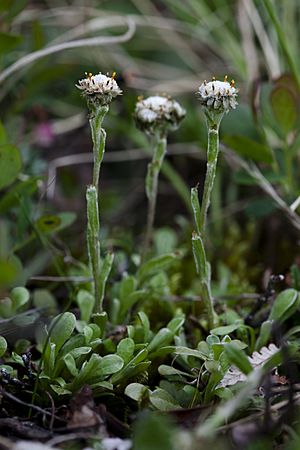Pygmy pussytoes facts for kids
Quick facts for kids Pygmy pussytoes |
|
|---|---|
 |
|
| Scientific classification | |
| Genus: |
Antennaria
|
| Species: |
monocephala
|
| Synonyms | |
|
Synonymy
Antennaria exilis Greene
Antennaria nitens Greene Antennaria philonipha A.E.Porsild Antennaria shumaginensis A.E.Porsild Antennaria angustata Greene, syn of subsp. angustata Antennaria komarovii Juz. ex Kom., syn of subsp. angustata Antennaria megacephala Fernald ex Raup, syn of subsp. angustata |
|
Antennaria monocephala, often called pygmy pussytoes, is a tiny plant that loves cold places. It gets its common name because its flower clusters look a bit like a cat's paw – soft and fuzzy! This small herb is native to very cold, high-up areas in North America and parts of Russia.
Contents
What is Pygmy Pussytoes?
Pygmy pussytoes is a really small plant. It usually grows to be no taller than your hand, about 15 centimeters (6 inches) high. It's a tough little plant that can survive in harsh, cold environments.
Plant Parts and Life Cycle
Interestingly, pygmy pussytoes plants can be like "boys" and "girls." This means that the male flowers (which produce pollen) and female flowers (which produce seeds) grow on separate plants. Sometimes, you might even find whole groups of only female plants growing together.
Where Pygmy Pussytoes Lives
You can find this amazing plant in very cold, high-up places. It grows in the Arctic and in alpine regions, which are areas high up in mountains.
Its Home in North America
In North America, pygmy pussytoes grows in many northern and western areas. These include:
- Greenland
- Parts of Canada, like Labrador, Quebec, and the three Canadian Arctic Territories
- Alaska
- British Columbia
- Alberta
- Wyoming
Across the Ocean
This plant also grows across the Bering Strait in Russia. You can find it on the Chukotka Peninsula, which is sometimes called the Chukchi Peninsula. This shows how tough and adaptable this little plant is!

